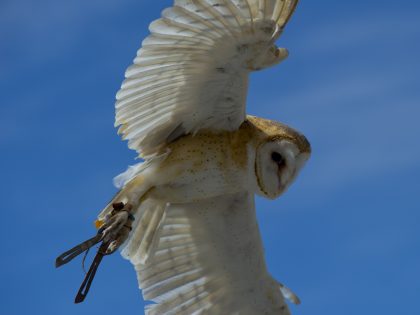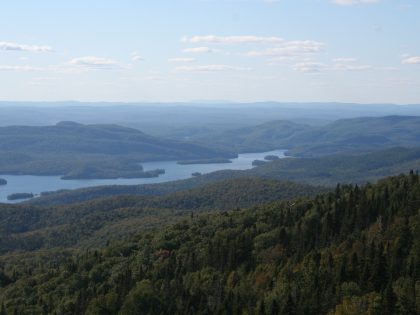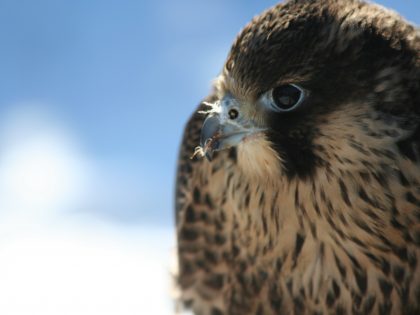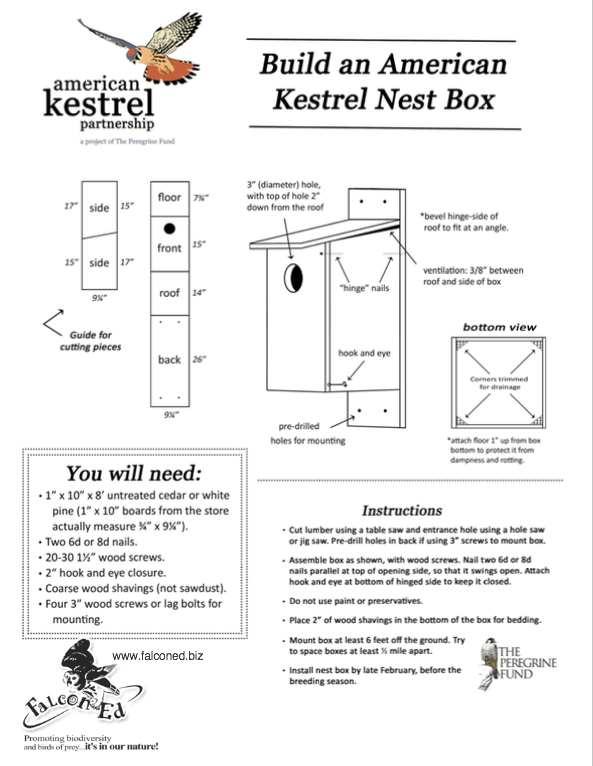SUPERSTITIONS AND PERSECUTION
Humans and raptors have had an interesting relationship; at once, we worship birds of prey for their amazing hunting abilities, and persecute them for being killers.
Superstitions
Historically, and even today, the spiritual and cultural beliefs of human societies help seal the fate of many species. A species which is venerated will be respected and conserved. Some tribes living in the south of Australia attach great importance to certain animals. One of these is the owl. These tribes believe that every man is represented by a bat and that each woman is represented by an owl. Since no one can know which owl holds which human spirit, all owls are left untouched.
Not all “important” raptors are protected. In South America, the Andean Condor is very respected because many believe that it has magic powers. Some peoples will then kill condors to collect their feathers for use as healing charms. In certain parts of Africa, some believe that vultures are able to find hidden carcasses by dreaming of the location. Using this logic, these individuals will kill a vulture and eat its brain, hoping this will help them predict the future outcome of a race or game. In all truth, vultures find their prey by using their keen eyesight.
Now, if venerated species are killed and sacrificed, we can imagine that species which are considered evil or pests receive the worst treatment of all. Many cultures from Europe’s past associated owls with witches, evil spirits and death. Often, their hatred and fear lead them to kill owls and nail the birds’ carcasses on their doors and fences to keep bad spirits and enemies away.
Finally, raptors are often symbolically important to many religious and spiritual beliefs. The Kwakiutt First Nations of British Columbia believe that two eagles, descended from the sky, became the first man and woman on the planet, after removing their feathers of course. Other First Nations living in Alaska say that an eagle, with the help of a Blue Jay, would be responsible for creating life on Earth.
Persecution
Besides our fear and unfortunate superstitions, we have seemingly persecuted raptors for valid reasons. Birds of prey have been poisoned and killed because they could attack livestock like chickens and geese and lambs, and also because many hunters saw them as competitors for small game. Not that long ago, millions of birds of prey were killed each year. In the 16th century, a bounty was offered to those who killed them, all this to protect domestic farm animals. The height of our persecution was the period between 1850 and 1900 because of the great popularity of small game hunting in Europe and in North America. Large raptors were the main target. Up until 1960, eagles were shot out of the sky using small planes and helicopters. More than 2,000 eagles were killed in this manner in the American south-west during this period. Scavengers were also easy targets because one could simply lay out a poisoned carcass.
ENVIRONMENT
Habitat Destruction, Deforestation, Agriculture…
Modern agricultural practices make the environment uniform, with fewer varieties of plants and less variety of habitat. When a habitat changes, the animals living there also change, whether predator or prey. Many raptor species which are forest hunters have had a hard time adapting to the loss of trees and the ever expanding agricultural fields. Others, like the Red-Tailed Hawk have been on the winning side of things because they love to hunt in open areas, like fields. Red-Tailed Hawks are the most common birds of prey in North America, but at what cost?
Habitat fragmentation, where a big forest is transformed into a few stands of trees, is also a factor. These habitats are too small and too isolated, making feeding, nesting and finding a mate more difficult. Populations of the Northern Goshawk are being studied in British Columbia in relation to the fragmentation of their habitat. Pollution, agriculture and forestry can make the environment less inviting, this is called environmental degradation; these also decrease prey populations. Depending on the availability of food and the raptor species in question, a raptor’s territory can vary between 3 square kilometres (Kestrel) to more than 100 square kilometres (Eagle). When prey become scarce, a raptor must take on a larger territory and compete more with others. Sometimes raptors die of famine before finding their next meal.
Modern agricultural practices have had a devastating effect on vultures. Nowadays, dead cattle and livestock are no longer left for the scavengers, but either buried or burned. Many vultures now find their meal in garbage dumps. In other parts of the world, like Africa and Asia where carcasses are still available to vultures, things are no better. The livestock which they feed on often contain a veterinary drug called diclofenac. Diclofenac is lethal (deadly) to vultures. Some vultures that were once very common have quickly become rare.
Certain raptor species, like the Northern Harrier and the Burrowing Owl, nest on the ground and sometimes inadvertently nest in farmers’ fields’. Only conscientious farmers will think to relocate a nest during harvest time, many other nests are otherwise destroyed.
Finally, the sprawling cities and suburbs threaten wild raptors even more so. Not only because they replace the habitat that was once there with concrete, pavement and sod, but also because the presence of humans may interfere with nesting and mating. Some raptors are very shy and may abandon a nest, even if there are eggs, if it is too often disturbed.
Pesticides and heavy metals
To date, one of the biggest threats to birds of prey has been the use of powerful insecticides. The most noxious pesticides are organoclorides such as DDT and cyclodienes. These are so poisonous because they are toxic and very stable (hard to breakdown), this means that they stay in the environment for a very long time and that they dissolve easily in greasy substances and can accumulate in animal fat. These toxic substances are passed on from animal to animal in the food chain, and become very concentrated in predators that are at the top of the food chain like raptors; this is called bioaccumulation. Raptors that feed on birds and fish are more affected than those that eat mammals. Once DDT is ingested it’s turned into DDE. This by-product leads the egg’s shell to be very thin, and then the egg either breaks inside the female or breaks before the young is ready to hatch. Cyclodienes are very toxic and target adults. With DDT preventing the production of young raptors and cyclodienes affecting the health of adults, when both are present in the environment the effects can be devastating. The use of DDT, and similar substances, has since been abolished in North America but it will take generations before its toxic residues are gone from the environment.
Heavy metals like mercury and lead can also poison birds of prey. Mercury is found in fertilizers and pesticides. Lead finds its way into the bodies of raptors because they often feed on the carcasses of wild game (ducks, pheasants, partridges) that were shot but uncollected.
Raptors are part of the balance…
It has been estimated that during its mating season, from April to July, the Short-eared Owl couple and their 4 or 5 owlets will devour approximately 45kg (100lbs) of meat, which represents 1500 small rodents! If we consider the posterity of the field mouse which is of 1 millions individuals, we wouldn’t want to live in a world without owls.
Peregrine Falcons have not only made a comeback after its near extinction due to DDT, the survivors have been able to adapt to a seemingly hostile human environment, the downtown core! It is not uncommon to witness these falcons nesting on the ledges of sky-scrapers and happily hunting all the pigeon they desire.
On the other side of the planet, the Buddhists ofTibet transport the bodies of the dead to high platforms in the mountains where the body is dismembered and cut and left for the vultures. In a similar practice, the Parsis of India leave the dead for the vultures as well in special mortuaries. The vultures serve as a spiritual link between the heavens and the Earth.
PROTECTION AND REHABILITATION
After years of persecution, people have finally realised the harm that has been unjustly done to raptor populations. The near extinction of symbolic species like the Bald Eagle and the Peregrine Falcon have brought their importance into perspective.
There now exist many laws to protect birds of prey. It is illegal to capture, poison, kill or harm them, and to disturb their nests. Only some species may be kept in captivity with the valid permits.
Many government institutions, organisations, universities and private companies study, conserve and monitor wild raptor populations. Many a raptor’s nest will be visited to band the young and to collect information that will help all of us better understand birds of prey.
Other organisations like UQROP (l’Union québécoise pour la réhabilitation des oiseaux de proie) (www.uqrop.qc.ca), situated in Saint-Hyacinthe (Quebec) have the mandate to nurse back to health injured raptors and release back into the wild. A network of volunteers and wildlife agents help transport nearly 300 birds annually to its clinic.
If you find a dead bird that has a band on its ankle please phone this number : 1-800-327-2263 or contact a wildlife agent. For any suspicious death of wild birds phone the Société de la faune et des parcs du Québec : (418) 521-3830 ou 1-800-561-1616.
How can we help?
Certain species of birds of prey are greatly affected by pressures that humans create through urbanization and development. Some can be encouraged with our help, in order to succeed. For example, the American Kestrel confronts nesting competition with the European Starlings (Sturnus vulgaris), as they are both cavity nesters looking for natural spaces to breed. An appropriate nest box can be installed to welcome these small falcons in the Spring time.







